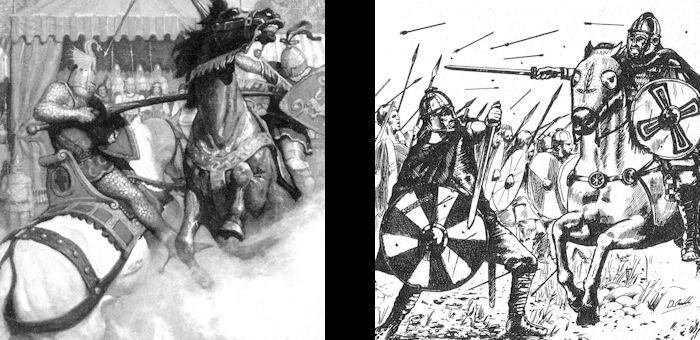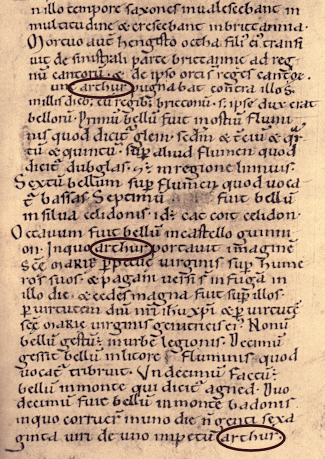Page 2 of 6
The Lost Tomb of King Arthur

In the popular Arthurian stories, the Knights of the Round Table are depicted as warriors of the Middle Ages, as shown above left. The drawing on the right, made by Dark Age military expert Dan Shadrake, shows the real armour and weapons of the period Arthur is said to have lived around the year 500.
Why, then, do many historians continue to doubt that King Arthur was a real, historical figure? This is partly because when most people think of the Arthurian story they recall the fanciful tales. Clearly King Arthur as he is depicted in these elaborate fictions did not exist. More significantly, however, from the academic perspective, no contemporary inscription or historical documentation, or any archaeological find from the period in question, has yet been uncovered bearing Arthur’s name. Nevertheless, this should be not in its self be regarded as evidence that Arthur did not exist. From this turbulent time, when law, order and civilization had broke down, and there was continual infighting, few written records of any kind have survived. Many historical figures went unrecorded, and others have been forgotten completely, as records were unwritten, lost or destroyed.

A Historical Figure
Angle and Saxon invasions of Britain in the late fifth and early sixth centuries.
During the Middle Ages many tales were written about King Arthur and his knights. Although certain themes within these so-called Arthurian romances - such as the supernatural, mythical beings, and damsels in distress - are clearly invention, a much older manuscript, written three centuries before the earliest of these tales was composed, records that Arthur had been an historical figure. The work of the ninth-century writer Nennius, the History of the Britons, refers to Arthur in a purely historical context, unfettered by such flights of fancy. The Britons were the native Celts who occupied all of Britain before being pushed into Wales by the Angles and Saxons, collectively called the Anglo-Saxons, who invaded the country from their homeland in northern Germany. Arthur, Nennius tells us, was one of the last leaders of the Britons to make a successful stand against the Anglo-Saxons around the year 500. This was during the early Dark Ages, an era of tribal feuding, following the collapse of the Roman Empire in the fifth century, when Britain had divided into many kingdoms. If Arthur lived in the late fifth or early sixth century as Nennius records, he would not have been a king in shining armour, but a Celtic chieftain struggling against civil strife as well as foreign invasion. The reason Arthur is now portrayed as a medieval-style king of many centuries later is that medieval writers tended to set ancient stories, such as the legends of Greece and Rome, in their own historical context: a context of knighthood and chivalry. If Arthur really existed, he and his warriors would have been very different from the Knights of the Round Table. The warlords of the fifth century wore late Roman-style armour, and their fortifications were not huge, Gothic castles but wooden stockades.

The oldest surviving work to provide any details concerning Arthur’s life is the History of the Britons by Nennius. Sadly, Nennius fails to say where Arthur originated. However, he does list his battles, and the last of them, the Battle of Badon, was a historical event known from a much earlier source. The British monk Gildas, who wrote within living memory of the battle, makes reference to the Battle of Badon occurring around AD 500, precisely the time Arthur is said to have lived. Regrettably, although Gildas says that the Britons were victorious, he fails to name their leader. Badon (probably fought near the city of Bath) was the most important battle of the era, after which the Anglo-Saxons were forced to retreat. The Anglo-Saxons' own records, and the evidence from archaeology, shows that they were pushed back into eastern Britain for around two decades between 500 and 520 - the very period Arthur is said to have ruled. This all implies that during this time the Britons had a powerful, unifying leader. Yet the name of this leader is not recorded in any surviving contemporary manuscript. The oldest writer to name a British leader in connection with these events is Nennius - who calls him Arthur. Accordingly, even though some of Arthur’s exploits as proposed in the romantic works of the Middle Ages may have been fictitious, there is good reason to accept that a man called Arthur did lead the Britons at the time the accounts place the legendary King Arthur.
Page from the History of the Britons by Nennius. Written in Latin around AD 830, it records a historical Arthur who lived around the year 500.








